The True First Easter Egg: Ready Player One Was Wrong
- What was the first Easter Egg in an arcade game?
- What was the first Easter Egg in a cartridge game?
- What was the first Easter Egg in a computer game?
This is a transcript of the video above. The article version contains only a fraction of the visuals; I recommend watching the video for the full experience.
Critical Kate Is On The Case
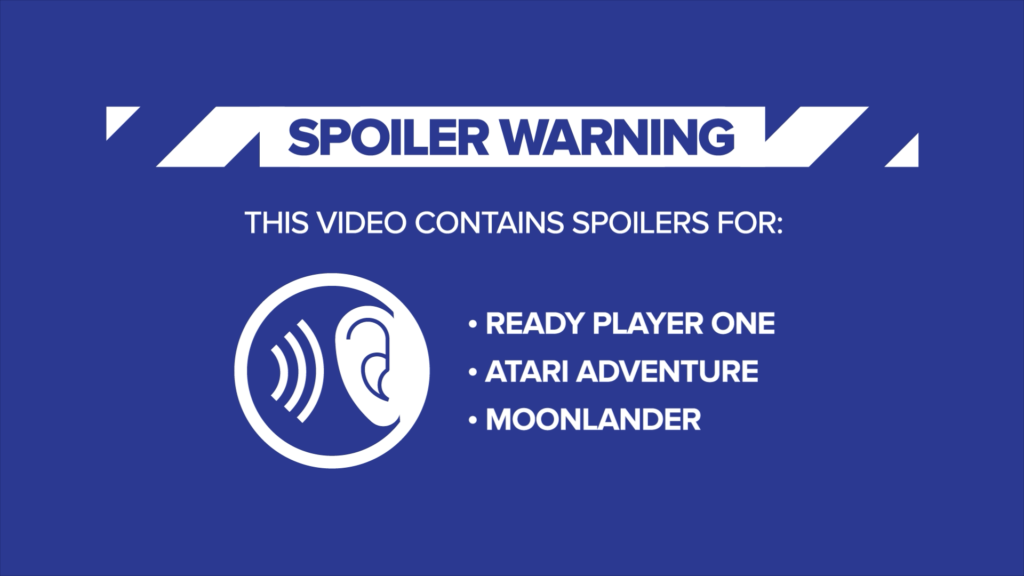
Ready Player One takes place in a dystopian future where people cope with the miserable state of their reality by escaping into a virtual one — a scenario I can’t relate to at all.
Their destination of choice is a simulation called the OASIS, a gaming paradise created by James Halliday. Halliday posthumously reveals that he’s hidden a game within his game — an Easter Egg hunt of sorts — and the prize is ownership of the OASIS.
The final Easter Egg in Halliday’s game involves finding the first Easter Egg in a video game, leading the protagonist on a hunt inside Atari Adventure.
Parzival: “...and that’s when you found the first Easter egg ever put in a video game...”
Except, it wasn’t the first Easter Egg in a video game.
Ready Player One was wrong.
Ready Player One Was Wrong
But before I tell you about what Adventure wasn’t, let me tell you what it was.
Atari Adventure was a dungeon exploration game where you search for three keys to three castles while avoiding the three dragons. Or you can simply kill them. Inside the final castle is a glowing chalice. If you bring it all the way back to the first castle, you win the game.
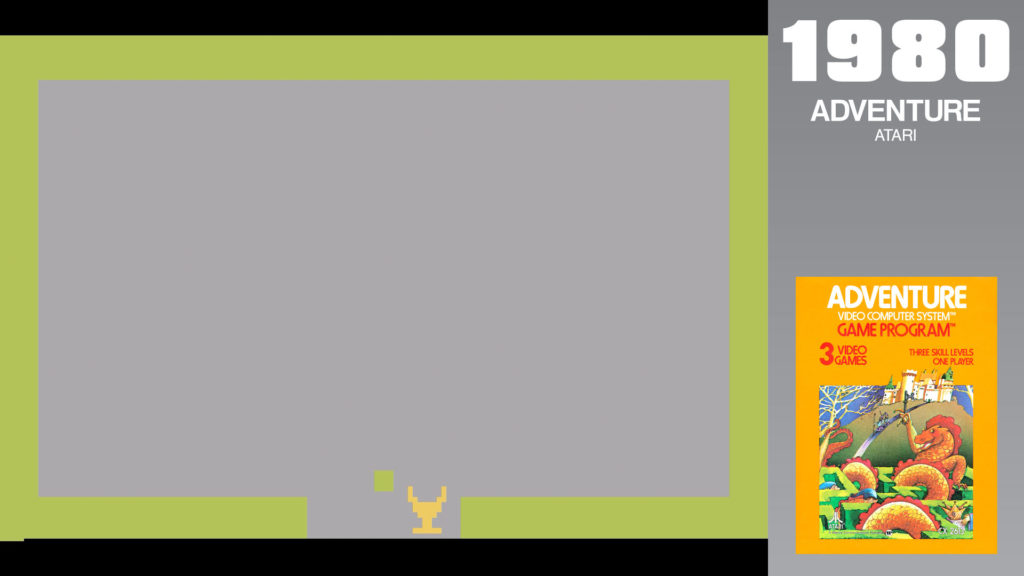
This might look primitive by today’s standards, but in many ways it was ahead of its time. Most games were still restricted to a single screen, so it was highly unusual that a game take place across multiple screens. And even more unusual to not include either a timer or a score. The game doesn’t even have a limit on lives. When you die, everything remains where you left it until you manually reset. Except any dragons you killed.
In order to reach the final key to the final castle, you need to use a portable bridge that lets you climb over walls. But if you drag that bridge all the way to the opposite side of the map, you can use it to enter a room that has no doors. Inside, you’ll find an egg-sized dot that’s the same color as the ground.
Near the beginning of the game is a mysterious fence. If you drop two additional items on this screen — or just the black key — the fence will open up, allowing you to see the hidden message.
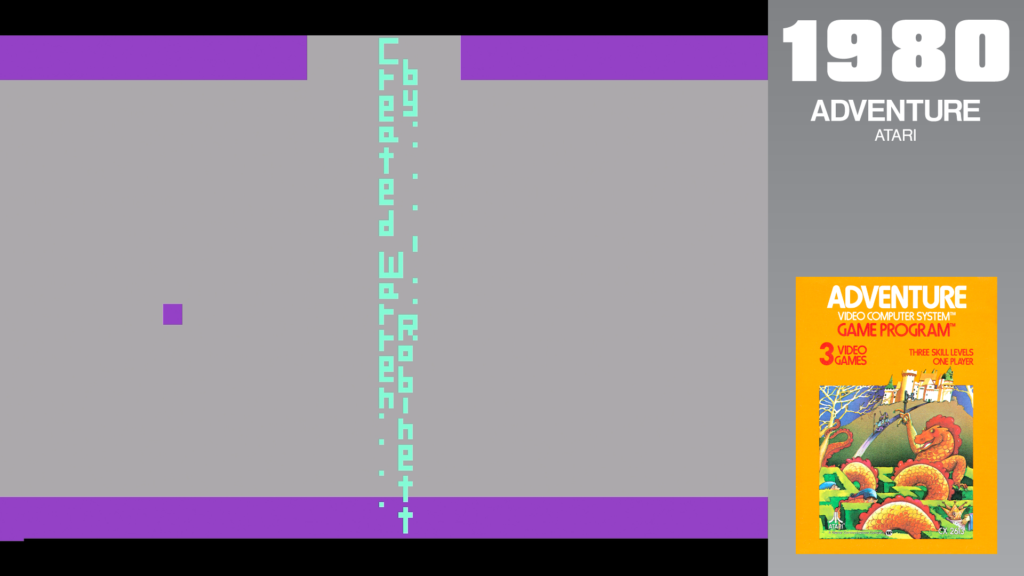
Warren Robinett was inspired by hidden messages in Beatles records. But he decided to sign the work with his name to rebel against the common industry policy of not allowing authors to be credited.
What Robinett didn’t realize is that he wasn’t the first one to do it.
Backwards As Fast As We Can
Atari is regularly given credit for innovations they didn’t do. Atari didn’t invent Pong, they simply improved on it. They didn’t invent games on cartridges; Fairchild’s Channel F beat them to it by almost a year. And Fairchild also beat them to them to Easter Eggs in games on cartridges.
Video Whizball is essentially a video game version of Crossfire, the most ‘90s board game to ever come from the ‘70s, except now the pucks can kill you. But don’t worry, you always respawn.
Once a match finishes, if you wait for a moment where you’re both dead before you head back to the main menu — and if you select Game 4-3 as your next match with a Score of 67 — you’ll discover the name of programmer Brad ReidSelth.
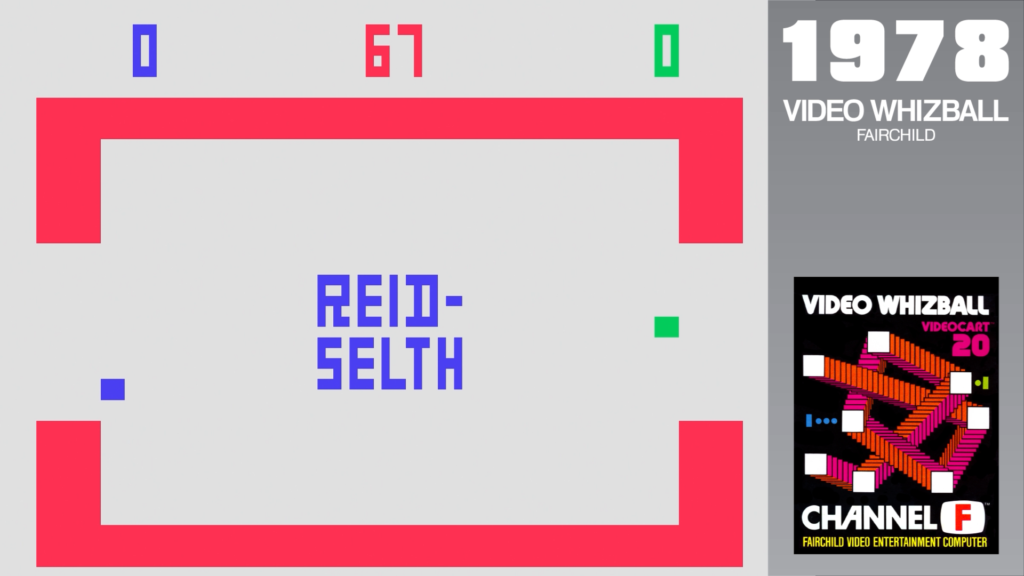
He did this despite, or maybe because of his superiors explicitly warning him not to. Rumors existed of programmers indulging in these demonstrations of vanity at companies like Atari, and Fairchild wanted nothing of it.
But wait, if Adventure wasn’t released yet, how could there already be rumors? Maybe the answer can be found in Atari’s arcade game division.
This is the attract mode for Atari’s Starship 1. Before you insert a coin, hold down both phasors and the start button. Then, when you release the coin, let go and quickly hit the “Slow” lever. In the upper left corner you’ll see a message that says “Hi Ron.”
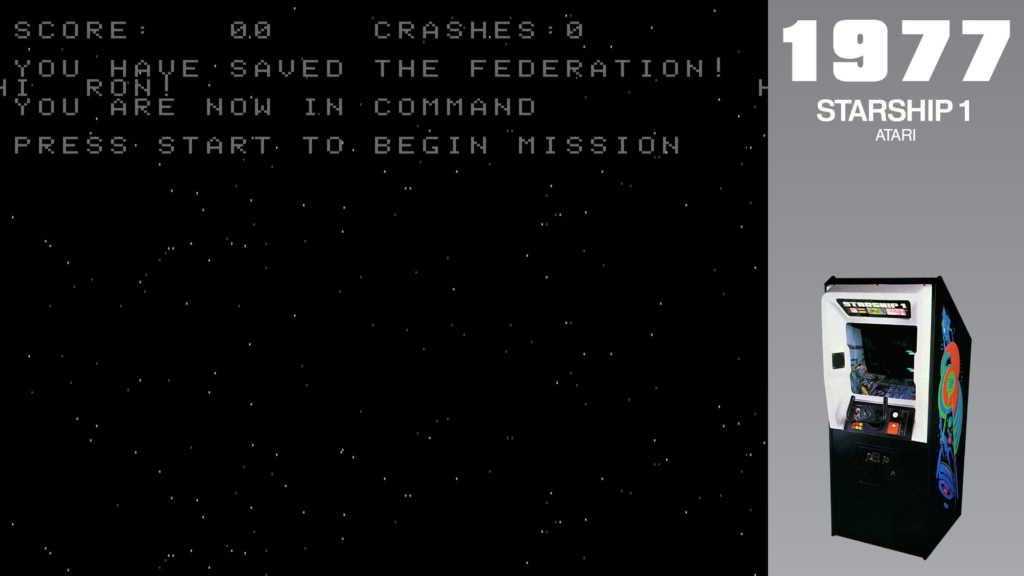
Programmer Ron Milner kept this a secret for over 30 years, in part because this is a confirmation message that you’ve just been given ten free games, making this possibly the first ever cheat code in a video game.
But rumors don’t start over well-kept secrets. So why was Brad ReidSelth warned against doing this at Fairchild? Unless…could Fairchild be the source of the rumor?
This is the menu screen for Spitfire, which was released a year and a half before Video Whizball. It’s asking whether you want to start a 1-player game or a 2-player game, which you select by pressing “1” or “2” on the face of the console itself.
But if you press “3,” the game quietly activates a secret mode that’s waiting for you to enter in a lengthy button code.
Except the goal isn’t to enter it as quick as you can. Instead, you need to type the sequence extra slowly, or the individual inputs won’t register. If you do it correctly, you’ll see the programmer’s name appear, and then disappear just as suddenly.
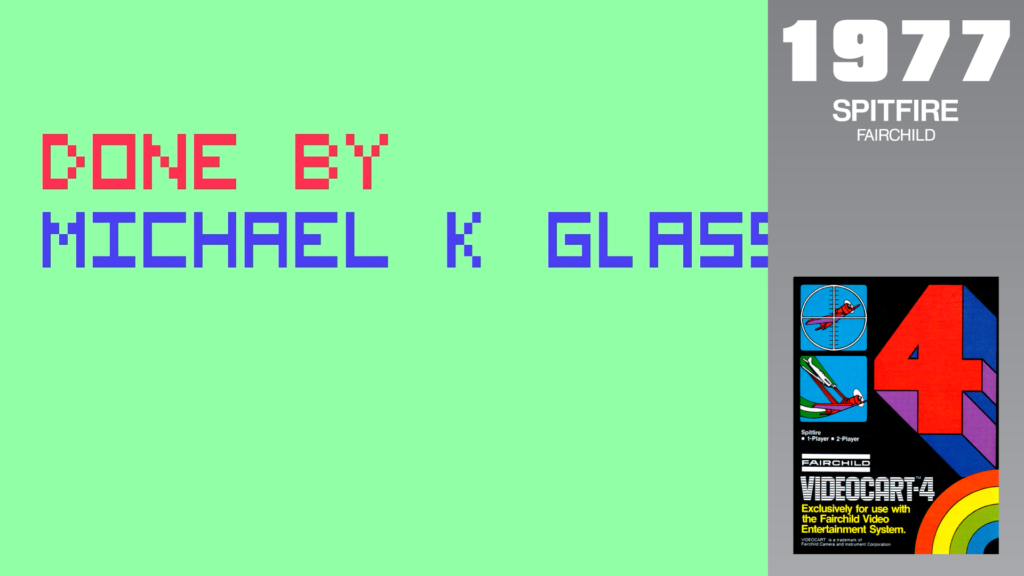
Brad ReidSelth had no idea Michael Glass was doing things like this, but his superiors might have. You see, while the Easter Egg works just fine on an emulator, it can’t be activated while using an original cartridge. Something inside it changed between the programming and final pressing.
Whether or not this change was intentional, we’ll never know for sure. What we do know is that this is almost certainly the first Easter Egg in a cartridge game.
But it’s still not the first Easter Egg in a video game.
One Small Step, One Giant Leap
In October of 1972, DEC released the GT40, a vector monitor with a light pen accessory. The only thing missing was a flashy demonstration program to show off what it could do. So they contracted former employee Jack Burness (BUR-ness), who spent ten days whipping up a game he called… Moonlander. It became the GT40’s killer app.
The Apollo program landed on the moon six times between 1969 and 1972. Burness even attended the final launch just months before designing his game. The heightened public interest in the topic no doubt helped players power through the game’s steep learning curve.
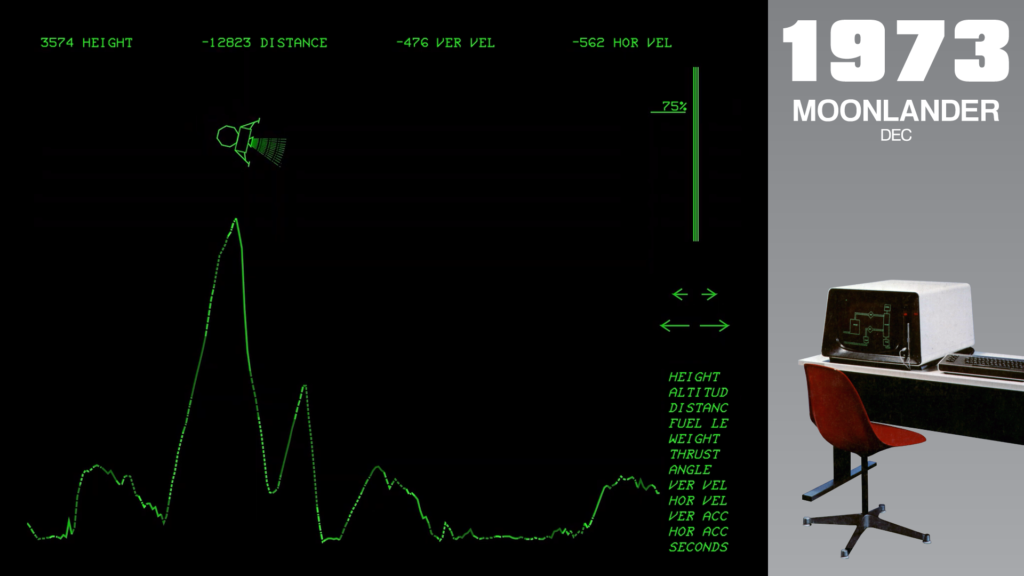
The objective is to land your craft using your light pen to interact with the graphical interface located to the right. The tall bar controls the thrusters and the arrows control rotation, with the small arrows providing finer control. The instruments along the top display your current status, and can be switched out like widgets using the list to the side.
But just when you think you’re about to land, a jarring shift occurs. The surface changed, and your ship was moving visibly faster. That’s because the initial screen is actually an overworld map — the first ever in a video game!
And that’s not all! Once you get the hang of flying, you discover that this is the first game to take place across multiple screens! It also doesn’t include a timer or a score, or even a limit on lives! When you die, everything remains how you left it until you manually reset.
The tricky part, of course, is landing. The physics are very unforgiving. But once you master it — with help from the first ever contextual tips in a game — you’re greeted with a few more surprises: the first ever human-shaped sprite, in the first ever cut scene in a video game!
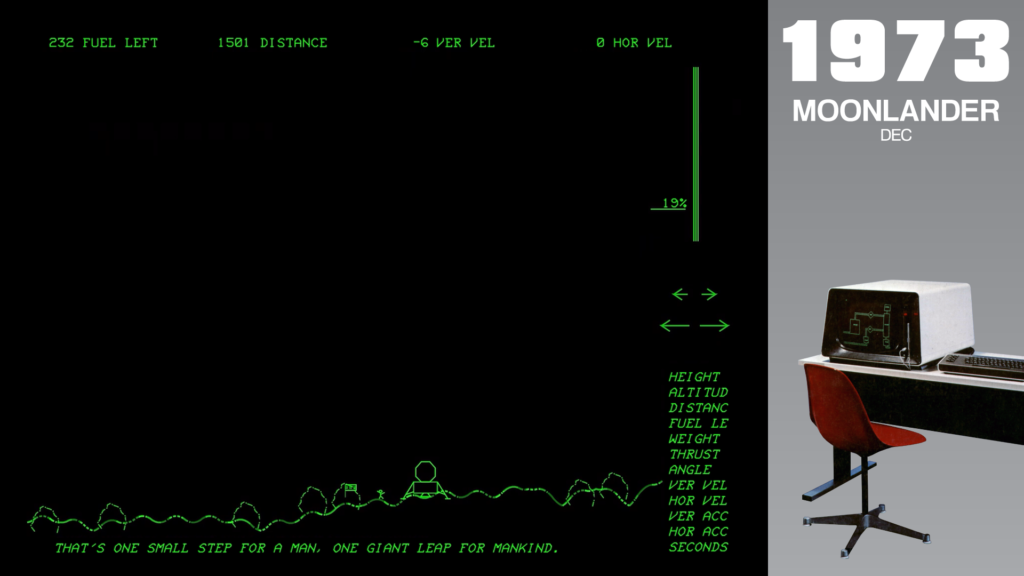
I cannot stress enough just how ahead of its time this all is! This is the beginning of 1973, right after the release of Odyssey and Pong!
Anyways! Once you’ve mastered landing, you naturally want to explore. Which leads you to discover a mysterious object on the moon’s surface. This has to be something important.
If you can perform a successful landing next to it, you’ll see your little spaceman get out of his ship and slowly wander towards it, eventually stopping at the main structure, and revealing the author’s— wait, it’s a McDonald’s?
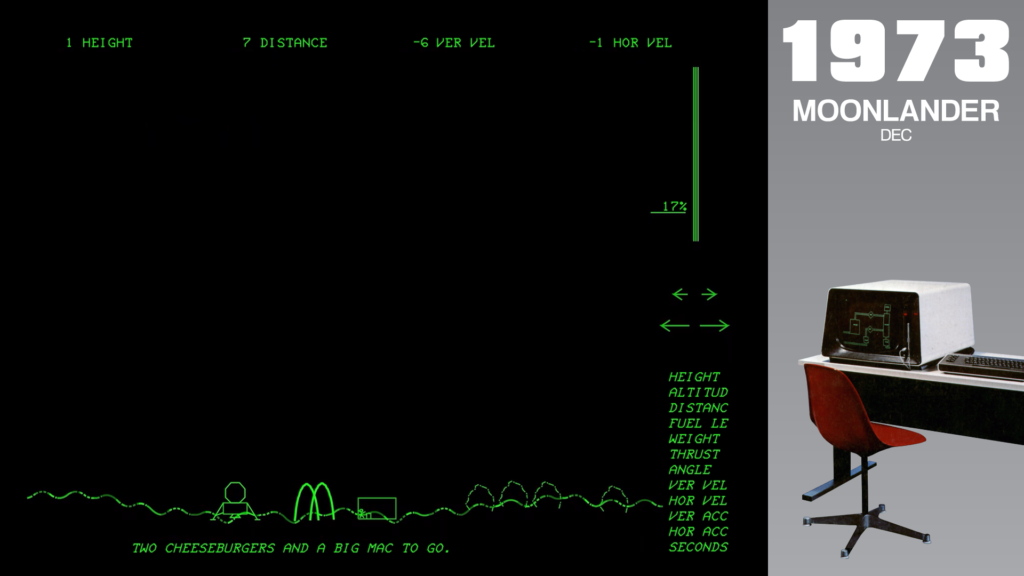
It’s a fucking McDonald’s?
You’re telling me that all these programmers who were sticking it to man in their own little triumphs against anti-creator corporate values…were beat to the punch by a tribute to the most pervasive corporate symbol on the planet?
I’m just kidding, I actually find this hilarious.
And to be fair, McDonald’s wasn’t all that pervasive yet in 1973. In fact, there were so few near DEC, Burness ended up spelling the name wrong when you crash into it! What a clod.
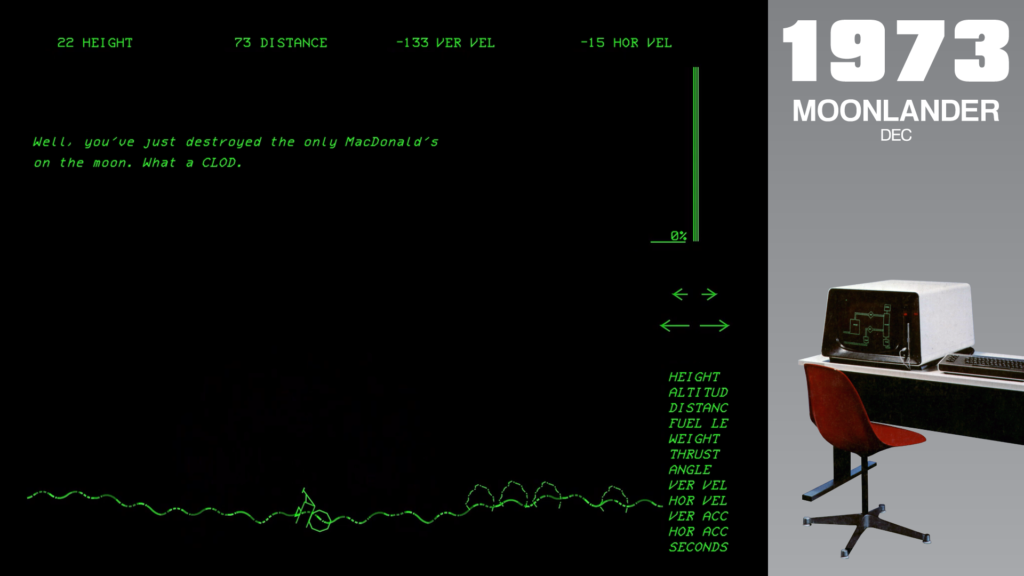
To my mind, this Easter Egg is just another example of Moonlander being ahead of its time, because today this is what most Easter Eggs are. Brands hidden in the background that we freeze frame so we can see how many we recognize, and then write a blog post about it.
The real question is: if Ready Player One takes place in the future, why don’t they know about these other Easter Eggs?
The answer, of course, is because the primary theme of Ready Player One is that James Halliday Is Wrong.
James Halliday Is Wrong
Take, for example, his preferred scenario for playing Goldeneye:
Art3mis: “James Halliday’s favorite first-person shooter.” Parzival: “What? Oh. Goldeneye.” Art3mis: “Playing as?” Parzival: “Oddjob. Is this a test?” Art3mis: “Favorite game variant?” Parzival: “Game variant was ‘slappers only.’”
What a clod.
But maybe I’m being too harsh. Really, it seems like he’s always exactly half-wrong. He did like Goldeneye, after all. And even if he was wrong about Atari Adventure containing the first Easter Egg, it was still the first to be called an Easter Egg.
The term first appeared in the first issue of the first U.S. gaming magazine, Electronic Games. The editors didn’t explain to players how to find the secret, but they confirmed that there was one, and asked an Atari representative for his thoughts.
Behind the scenes, Steve Wright was trying to convince his bosses at Atari that hidden secrets could be a fun marketing tool. When he spoke Electronic Games, he unknowingly made history:
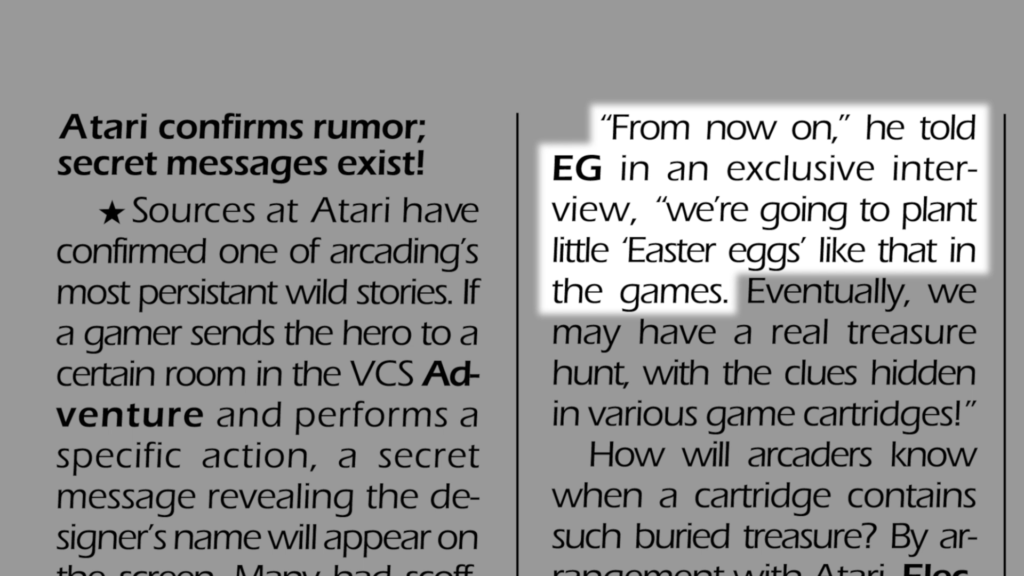
And that’s probably why Atari Adventure’s Easter Egg is so much more well-known than the one in Moonlander. That, and availability. Far more people had access to Atari 2600s than to expensive GT40s.
But Moonlander was played by several Atari programmers. They even adapted it into an arcade game called Lunar Lander.
Naturally, Atari’s version contained all the typical arcade features, like a timer and a score. Although, the timer actually counts up. I’m not sure why it’s even there. You have unlimited lives for as long as you have fuel, and you can add more fuel by pumping in more quarters. And they could do scrolling now, so you weren’t constantly cutting to a new screen.
Reporters who were unaware of Moonlander credited Atari with innovating “the only video game in the world that is an authentic simulation of a lunar landing mission.”
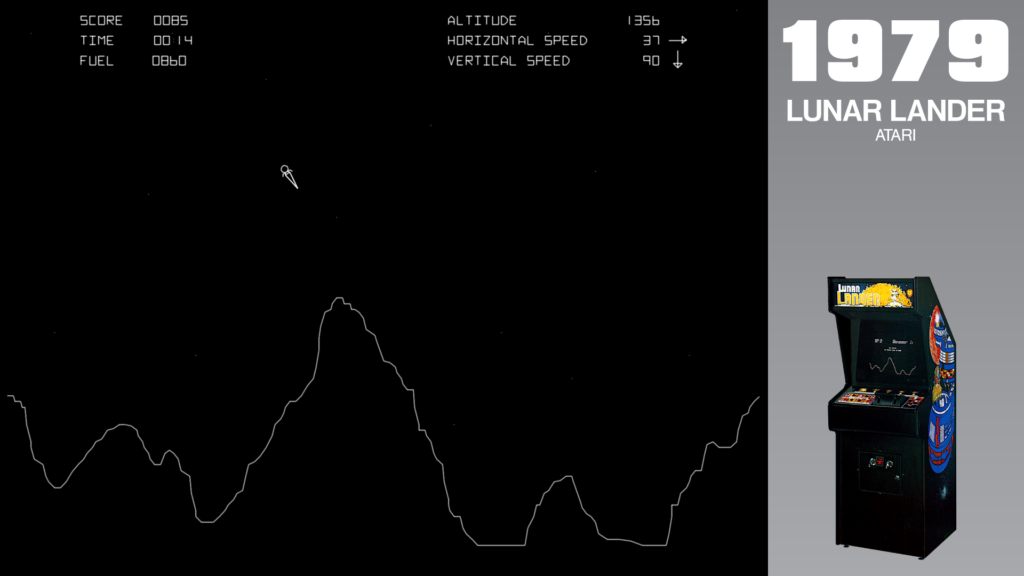
Which is funny, because the game’s difficulty levels are designed to make the physics easier for the average player.
But it’s a fun reworking of the original. I like that they included landing pads with varying point values, and the game could do scrolling now instead of constantly cutting to new screens.
Still, there’s one notable feature that’s sorely missing. A feature that could’ve made Lunar Lander as talked about today as Atari Adventure…
If only they’d had time to include the McDonald’s. The first Easter Egg in a video game.
If you enjoyed this, please consider supporting the site on Patreon!
Sources
- Adventure: Atari Archive Episode 33
- Apollo 17: On The Shoulders Of Giants (1973)
- Atari Compendium: Easter Eggs
- Brouhaha: DEC GT40 Graphic Display Terminal
- Brouhaha: Moonlander Assembly Source Code
- Correspondence between Brad ReidSelth and Fredric QJ Blåholtz
- Correspondence with Jack Burness
- The First Arcade Easter Egg (March 2017) by Ed Fries
- Forty Years Of Lunar Lander (July 2009) by Benj Edwards
- Game On! The Unauthorized History Of Video Games (2006)
- The Guy Who Coined The Term ‘Easter Egg’ Just Realized It Was A Thing (April 2018) by Bill Bradley
- Mens En Computer (1979)
- Sean Riddle: Channel F Info
- Select Button II: I Found An Easter Egg From 1977
- Magazines: Electronic Games, Replay, Retro Gamer
SPECIAL THANKS: Fredric QJ Blåholtz (ChannelF.se), Tony Bowe, Kevin Bunch (Atari Archive), Jack Burness, Caitlyn / CPI (PinballNovice), Dale Geddes (QuarterPast), Dan Hower (Flyer Fever), Dustin Hubbard (Gaming Alexandria), Ethan Johnson (History Of How We Play), Rich Moore, Rick Naro, Frank Palazzolo, Ryan Stevens (OtherWhiteTofu), Scott Stilphen (Atari Compendium), Stiletto, The Gaming Alexandria Community and The Secret Writers Society.
MUSIC: “Fast Talking,” “Cool Vibes,” “Backed Vibes Clean,” “Walking Along,” “Unseen Horrors,” “Faster Does It,” “Dances And Dames,” “I Knew A Guy” by Kevin MacLeod (incompetech.com)
Licensed under Creative Commons: By Attribution 3.0 (creativecommons.org/licenses/by/3.0/)
Comments
Join the discussion on my Patreon page!

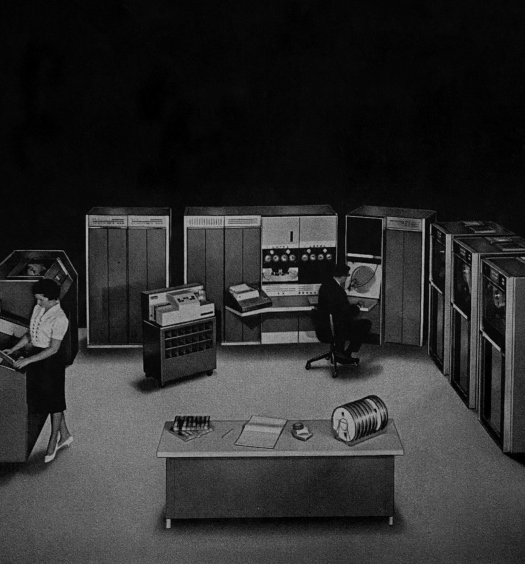
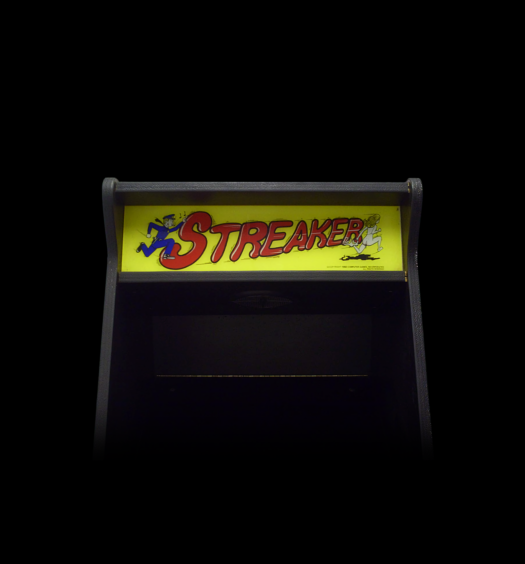










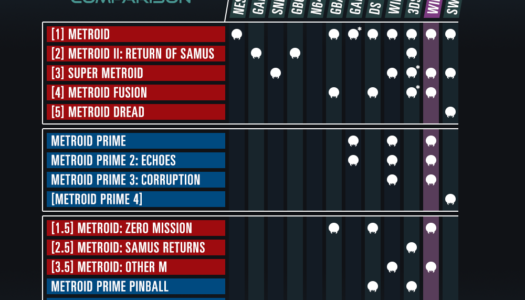
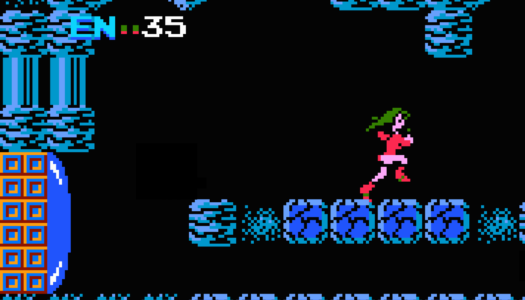
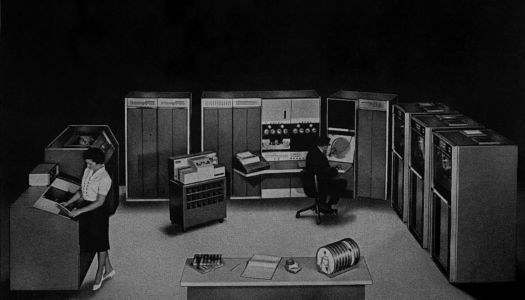
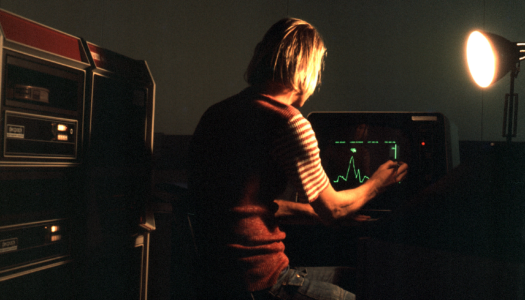
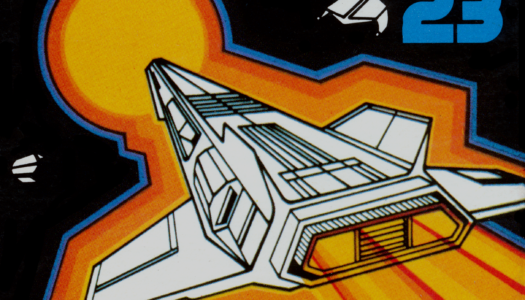

May 23, 2021
[…] when I received an email from Kate Willaert letting me know she had linked to my story in a recent video about early video game Easter Eggs and asking if I could help her out with another […]